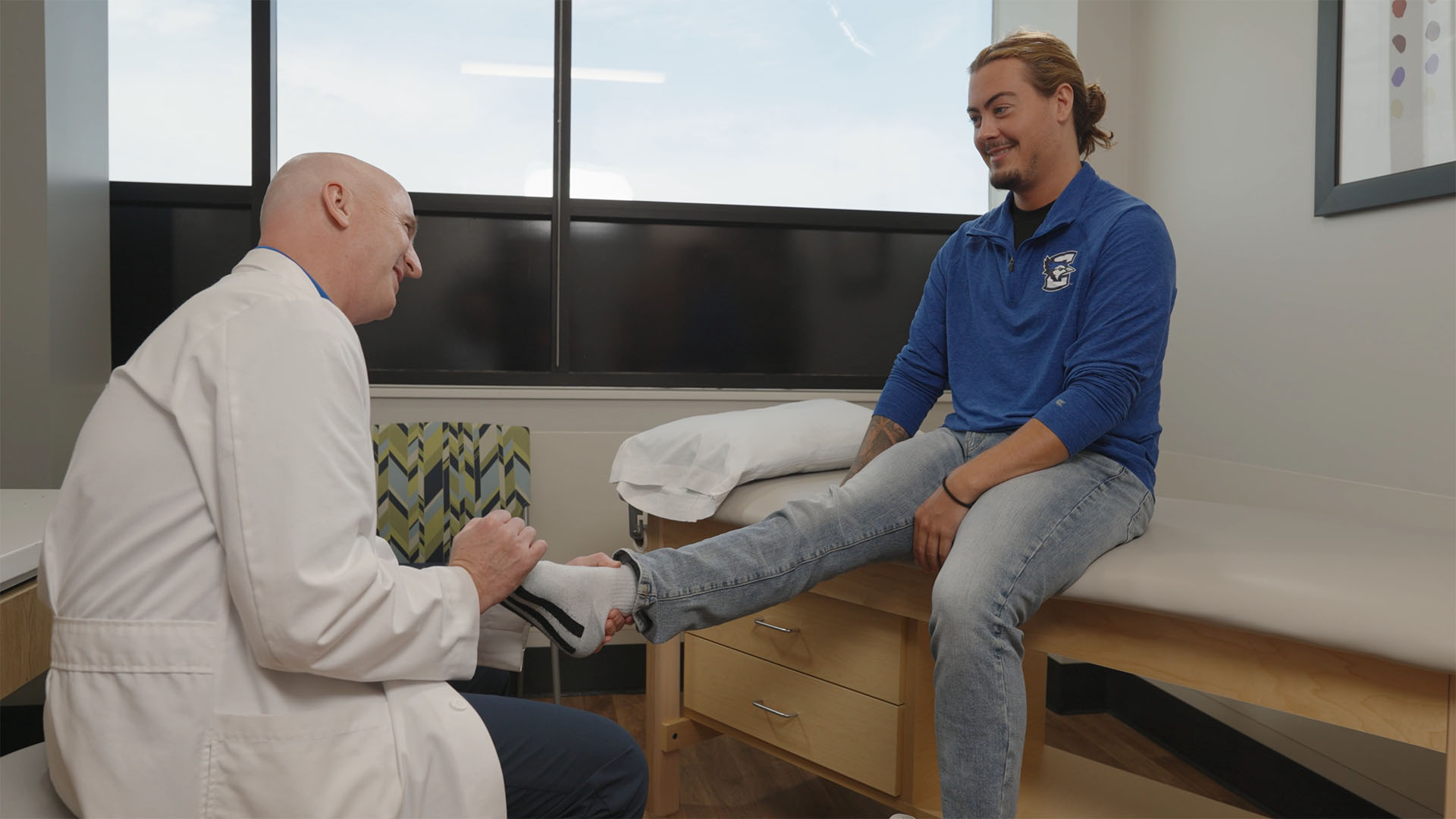Are you suffering from potential Arthritis of The Foot?
The Omaha Foot & Ankle Specialists at MD West ONE are able to properly diagnose and treat arthritis of the foot through both surgical and non-surgical treatments. If you have the following symptoms, you may want to make an appointment with one of our Board Certified Specialists.
- Tenderness or pain.
- Reduced ability to move or walk.
- Stiffness in the joint.
- Swelling in the joint.
Meet MD West ONE's foot and ankle specialists and learn more about how they treat arthritis of the foot.

Kathleen A. Grier, M.D.
Foot & Ankle Specialist

Scott T. McMullen, M.D.
Foot & Ankle Specialist

David J. Inda, M.D.
Foot & Ankle Specialist

Shane Schutt, M.D.
Foot & Ankle Specialist
Arthritis of The Foot Causes, Treatments & Surgery
What is Arthritis?
Arthritis is a general term for a group of more than 100 diseases. The word "arthritis" means "joint inflammation." Arthritis involves inflammation (swelling) in and around the joints. Pain, stiffness, and swelling can result from inflammation. Arthritis can be an acute or chronic inflammation of a joint and its surrounding soft tissues. In arthritis, progressive joint deterioration occurs and the smooth "cushioning" cartilage in joints is gradually lost, resulting in the bones wearing against each other. Soft tissues in the joints also may begin to wear down. Arthritis can be painful and eventually can result in limited motion, loss of joint function, and deformities in the joints affected.
What is Arthritis of The Foot?
Each foot has 28 bones are more than 30 joints. The most common foot joints that arthritis affects are:
- The joint where the ankle and shinbone meet.
- The 3 joints of the foot that involve the heel bone, the inner mid-foot bone, and the outer mid-foot bone.
- The joint of the big tie and foot bone.

The following factors put you at an increased risk for arthritis of the foot:
- Age - It is a common problem for many people after they reach middle age, but it may occur in younger people, too.
- Obesity - Increased weight puts more strain upon the feet, increasing the risk of arthritis.
- Family History

Ways to Decrease Your Risk of Developing Arthritis of The Foot:
- Wear supportive shoes - The shoes you wear are important. As we enter the spring season and abandon our winter shoewear, we need to be aware that our choice of shoes can contribute to foot arthritis. If you are experiencing foot arthritis symptoms, avoid unsupportive shoes, such as high-heels, and aim for shoes that have arch support and provide increased stability.
- Stretch achilles tensons - Frequent stretching can indirectly contribute to foot arthritis prevention. By stretching the ligaments and tendons in your foot, you can improve overall mobility and decrease your likelihood by injury. Decreased risk of injury will lower susceptibility of developing arthritic conditions.
- Visit your loca podiatrist - Foot arthritis is hard to self-diagnose, and luckily, you do not have to. Come see one of our experienced podiatrists and receive an in-depth evaluation of your condition and explanation of available treatment options.
Download & Save
Click the button below to download the PDF version of this information. By downloading the PDF, you can easily print the resource or save it to your desktop or mobile device for future use.

Diagnosis
The diagnosis of arthritis of the foot most likely will involve the following:
- A preliminary medical history in which the provider asks questions about when and where the pain began, as well as aggravating or alleviating factors.
- A test called a gait analysis, in which the healthcare provider measures your stride and the way you walk.
- X-rays.
Non-Surgical Treatment Options
Arthritis of the foot can be treated in many ways. Non-surgical methods to treat arthritis of the foot include:
- Weight control.
- Custom-made shoes or orthotics.
- Inserts that support the foot.
- Bracing for joint support.
- Using a cane or walker to take stress off the affected joint.
- Physical therapy.
- Anti-inflammatory drugs reduce swelling in the joints.
- Pain relievers.
- Steroid medication injected into the joints.
Surgical Treatment Options
More than one kind of surgery may be required to treat arthritis of the foot. Your doctor can select the kind of surgery that is best for you, depending on the type and extent of the arthritis you have. The following are some of the surgical options for arthritis of the foot:
- Arthroscopic surgery - This kind of surgery can help in early stages of arthritis. In arthroscopic surgery, an arthroscope (a small instrument about the size of a pencil) is inserted into a joint. The instrument projects an image onto a monitor that is viewed by a surgeon. The surgeon can then use tiny forceps, knives, and shavers to clean the joint area. Arthroscopic surgery can help to remove any foreign tissues or bony outgrowths (spurs) that are present in the joint.
- Fusion surgery - This kind of surgery, also called arthrodesis, involves fusing bones together with the use of rods, pins, screws, or plates. After healing, the bones remain fused together.
Post-Operative Recovery
Recovery time is dependent on which surgery our experts recommend. Following surgery, it is advised that patients stay off their feet and avoid physical activity for a certain period of time to ensure optimal pain relief and proper healing. We will provide more detail and specific aftercare instructions following your surgery.
Frequently Asked Questions?
Medically, arthritis simply means joint pain and inflammation. Over 100 different conditions can cause these symptoms, as well as swelling, stiffness, and deformation of the joints. Some forms of arthritis seem to come and go in acute bouts, while others linger as a progressive, constant source of discomfort.
The most common form of arthritis, osteoarthritis, stems from deterioration of the cartilage that normally cushions the joints against friction. Rheumatoid arthritis occurs when the immune system mistakenly attacks the joint structures. Other causes include uric acid crystal formation (gout), infections, and joint injuries.
Osteoarthritis commonly affects the feet as the result of many years of wear and tear. (Remember that your feet support your entire body weight whenever you jog, walk, dance, or stand still.) The more weight you carry, or the more pounding you allow your feet to take, the higher your risk for foot osteoarthritis.
American Orthopaedic Foot & Ankle Society
All of the foot and ankle surgeons in the practice are recognized members of the American Orthopaedic Foot & Ankle Society. It is the oldest and most prestigious medical society dedicated to the foot and ankle. The mission of the society is to advance science and practice of foot and ankle surgery through education, research, and advocacy on behalf of patients and practitioners. These physicians dedicate their time and energy to improving the patient experience and their knowledge in their field. For more information visit http://www.aofas.org.
MD West ONE Foot & Ankle Specialists:
The Foot & Ankle Specialists are all Board Certified and Fellowship-Trained, meaning they’ve focused their education, training and research on orthopaedic surgery of the foot and ankle.
